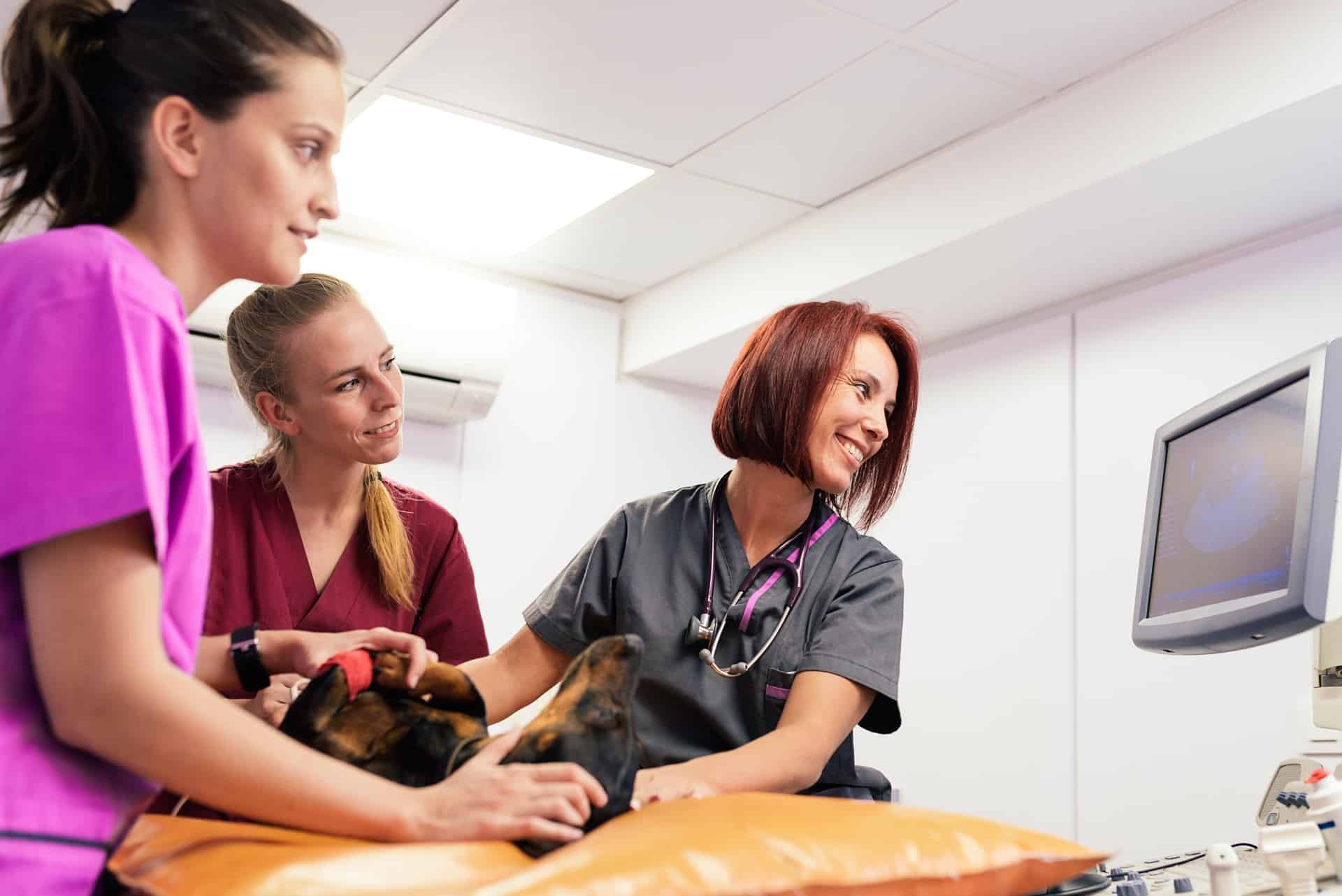How to Recognize Pain and Discomfort in Your Dog
It’s essential to recognize pain and discomfort in your pup. Here are some signs to look out for:
- Limping or lameness
- Agitation, restlessness or aggression
- Whimpering, yelping, or growling when touched
- Decreased appetite and drinking
- Excessive licking or chewing
- Panting or rapid breathing
- Changes in posture (sitting, standing, lying)
Note: Dogs may mask their pain, so be observant and proactive if you suspect any discomfort. Pro tip: Regular vet visits and close attention to your dog’s habits can help you catch health issues early – leading to a faster recovery.
Signs of Pain in Dogs
Do you know when your pup is in pain or not feeling well? It’s crucial to be aware, so you can get vet help quickly. Here, let’s go over some typical signs of discomfort in dogs.
What should you do if your dog seems to be hurting?
Changes in posture and body language
Dogs use body language and posture to communicate. If they change their posture or body language, it could indicate pain, discomfort, or unease. Look for signs like:
- Limping or favouring a limb
- Unwillingness to stand or move
- Hunched or arched back
- Panting or breathing heavily
- Protecting a part of their body
- Ears flat or tail tucked
- Avoiding contact or interaction
- Loss of appetite or sudden changes in behaviour
To make sure your pup is comfortable, pay attention to their non-verbal cues. They cannot express pain as well as humans, so be aware of these signs and seek vet care if necessary.
Loss of appetite
A lack of appetite is a typical indication of distress and hurt in dogs. It’s essential to identify this sign and take the right steps to ensure your pet’s health and contentment.
Other symptoms of pain to be aware of include:
- Whining, whimpering, or yelping
- Struggling to stand or walk
- Limping or favoring certain limbs
- Shun stairs or jumping on furniture
- Excessive licking or chewing of a certain area
- Always panting or seeming restless
- Showing aggression or sudden change in mood
It’s wise to talk to your vet if you think your dog is in pain. They can do a physical check-up, take x-rays, and give medicines or other treatments to alleviate your pet’s pain and boost their appetite. Pro tip – Regular vet check-ups can help spot pain or health problems before any symptoms show.
Behavioral changes
Dogs don’t talk, but their behavior can show us if they’re in pain. Responsible owners must be aware and take action to help. Possible signs:
- Aggression or irritability
- Licking/biting a spot
- Panting/breathing fast
- Decreased appetite
- Lethargy
- Yelping/whining when touched
- Changes to posture/gait
- Restlessness/pacing/circling
If you see any of these, take your pup to a vet right away. Early recognition and treatment can really make a difference.
Understanding your Dog’s Body Language
Know your pup’s body language! It’s key to know when something is wrong. Your pooch is trying to tell you something – if you learn to read their signs, you can quickly spot and tackle discomfort. In this article, we will go over the signals to pay attention to, and how to tell if your pup is in pain.
Dog’s Facial Expression
Dogs use their faces to show different emotions and feelings. To understand your pup better, take note of their facial expressions. Here are some common ones and what they mean:
- Relaxed: Mouth open and relaxed – means they’re chill.
- Happy: Relaxed mouth, sparkling eyes and a wagging tail – shows happiness.
- Fearful: Half-moon of white in eyes, pulled back ears and tense mouth – fear.
- Pain/Discomfort: Tense expression, squinted eyes and tight mouth – pain or discomfort.
It’s important to watch for changes in your dog’s face that might signal pain. If you see any, take them to the vet right away.
Tail Positions
Tail positions are key to comprehending your pooch’s body language and spotting any pain they may be feeling. Here are three usual tail stances, and what they could mean:
- High Tail – Curved tail held high is a sign of confidence, sharpness, and joy.
- Low Tail – Tail tucked between the legs suggests fear, apprehension, or submission.
- Tucked Tail – Tail tucked away hints at severe fear or distress. If you notice your pup’s tail tucked for a long time, take them to the vet right away to find the cause.
Understanding your pup’s body language and tail positions can aid you to communicate better with your furry best friend and guarantee their health and welfare. Pro tip: Spend quality time with your pup to observe their body language and get to know their unique tail positions.
Ear Positions
Dogs use their ears to express their emotions. So, it’s important to know the different ear positions.
Here are some common ear positions and what they mean:
- Forward and erect: Alert and engaged with the environment.
- Relaxed and loose: Relaxed and content.
- Flattened against the head: Fear or anxiety.
- Pulled back or sideways: Pain or discomfort.
By paying attention to your dog’s ear positions, you can understand their mood and physical condition. That way, your pup is healthier and happier.
Body Parts that Require Attention
As a pet owner, you need to know the body parts of your dog that may be in pain or uncomfortable. Take action quickly to give the right care before the condition gets worse.
Learn about these five body parts that require attention. Recognize when your dog is in pain or discomfort related to them:
- Head and ears
- Mouth and teeth
- Paws and nails
- Back and tail
- Hips and joints
Eyes
Your pup’s peepers are vital! As a pet parent, you must be aware of any discomfort in your doggo’s eyes.
Here are telltale signs of eye problems:
- Red or puffy eyes
- Discharge
- Different iris/pupil color or size
- Poor vision/closing of eyes
- Rubbing/scratching eyes
- Squinting/blinking too much
- Opaque eyes
- Itchy eyelids
If you spot any of these symptoms, take your pup to the vet ASAP. Remember, regular checkups and care can help avoid serious issues. Pro tip: Keep your pup’s eyes clean and dry, especially after a walk or playtime outdoors.
Ears
Ears are vital for a pup. It’s essential to acknowledge any signs of pain or uneasiness in your pooch’s ears to avert infections or illnesses. Here are several indicators that your pup may be going through ear pain or uneasiness:
- Consistent head shaking or tilting
- Scratching or rubbing at the ears
- Whimpering or yelping when the ears are touched
- Foul odor or discharge coming from the ears
- Redness or swelling in or around the ears
If you detect any of these signs, it’s important to take your pup to the vet for an examination. Routine ear cleaning and check-ups can also assist in avoiding any issues and keep your pup’s ears healthy.
Pro tip: Utilize a soft, damp cloth to clean your pup’s ears and do not insert anything into their ear canal.
Teeth and gums
Your pup’s teeth and gums are key to their health! Look out for any signs of pain or unease, such as:
- Peculiar breath or a change in scent
- Swollen, red, or bleeding gums
- Weak or absent teeth
- Discolored or cracked teeth
- Excessive drooling or trouble eating
- Pawing the mouth or face
If you see any of these, take your dog to the vet straight away. They might suggest a dental cleaning or other treatments. Routine brushing, dental chews, and a balanced diet can also help maintain good dental health. Pro Tip: Brushing your pup’s teeth is important but can take time. Start slow and reward them for good behaviour with treats and compliments.
Behavioral Changes in Dogs
Look out for physical signs, like limping, trembling, or changes in posture. Listen for vocalizations, like barking, growling, or whimpering. Also, observe changes in appetite, energy levels, and habits. These could all be signals of pain or discomfort in dogs. It’s essential to recognize these signs to ensure our canine companions are safe and healthy.
Changes in sleeping patterns
Changes in sleeping patterns can be a sign of pain or discomfort in dogs. As they age, their sleep may be disrupted due to physical issues, anxiety, or illness.
Signs to look out for:
- Restlessness in sleep
- Waking up at night more often
- Struggling to get up from lying down
- Limping or favoring a limb
- Lower appetite
- Changes in toilet habits
- Lack of energy or lethargy
If you see any of these changes, consult your vet. They can suggest pain meds, physical therapy, or a change in diet to help manage your pup’s discomfort.
Changes in mood
Changes in your pup’s mood could mean underlying pain or discomfort. Look out for:
- Lethargy, restlessness, decrease in appetite.
- Plus, increased aggression or irritability, excessive licking/biting of painful areas.
- Your pup might be scared/nervous, have difficulty getting up or down.
- They may whimper/yelp when touched or picked up, and have an arched back/tail between legs when standing/walking.
- These are all ways your pup is trying to tell you they are in pain. If you spot any of these signs, speak to your vet right away!
Changes in activity levels
Changes in activity levels in dogs can be a sign of pain or discomfort.
If your pup is usually active yet suddenly becomes lazy or less interested in playtime, it could be a sign of an underlying health issue. On the contrary, if your doggy is usually calm but has become much more hyper or destructive, it could mean stress or boredom.
Here are some behavioral changes to look out for:
- Unwillingness to exercise or take walks
- Sleeping more than usual
- More whining or whimpering
- Agitation or restlessness
- Loss of appetite
- Licking, biting or scratching a certain area
- Avoiding social interaction with humans or other pets
If you spot any of these changes, it’s best to talk to your vet. This way, you can rule out medical issues or address any environmental factors causing stress or anxiety.
Identifying Chronic Pain
Acute pain’s signs are usually obvious. Chronic pain, though, is much more difficult to detect. It’s milder and lasts longer. Recognizing chronic pain in dogs is especially important since they can’t tell us when it hurts. In this article, we’ll explain the symptoms of chronic pain in dogs and how to spot it.
Catching the subtle signs
Dogs are part of our family now and we must recognize when they experience pain or discomfort. It can be hard to notice signs of chronic pain in dogs since they hide it well. But it’s very important to know when they’re in pain, so we can help them. Here are some signs:
- Changes in eating/sleeping habits
- Grooming a certain area too much
- Limping or walking differently
- Not wanting to be touched or petted
- Heavy panting or being restless
- Whimpering when touched
By noticing these signs early and getting help from a vet, we can help our furry friends feel better and have a better life. Pro Tip: Regular checkups with the vet can help find these signs before they become too bad.
Visiting your veterinarian
Do you think your pup is in pain? Get to the vet quickly! Identifying chronic pain in dogs is tricky, so observe their behavior. Here are some signs:
- Limping or difficulty walking
- Whimpering/crying
- Refusing food/water
- Loss of appetite
- Lethargy/decreased activity
- Aggression
- Excessive panting/panting at wrong times
- Obsessive licking/grooming of certain area
- Change in posture/gait
Dogs hide discomfort well – so watch for subtle signs! If in doubt, get help from a vet to keep your furry pal healthy and happy.
Creating a care plan for your dog’s pain management
Recognizing chronic pain in canines is key for their general wellbeing. It is your job, as a pet owner, to spot signs of distress and formulate an arrangement for your pup’s pain control.
Here are some hints that your dog may have chronic pain:
- Variation in food or water consumption.
- Difficulty standing or walking.
- Whimpers, whines, or other vocalizations.
- Extra aggression or nervousness.
- Modifications in movement, such as unwillingness to climb stairs or jump onto furniture.
When you spot that your pooch has chronic pain, it is critical to collaborate with your vet to make a plan which could incorporate different treatments, such as medicinal drugs, physical therapy, or specialized diets. A customized plan will help your dog manage pain efficiently and live a fulfilled and healthy life.
Frequently Asked Questions
Q: How can I tell if my dog is in pain?
A: Dogs can’t verbally communicate their pain, so you have to look for physical signs like limping, whining, decreased appetite or activity level, licking/chewing at a specific area, or changes in behavior.
Q: Can dogs mask or hide their pain?
A: Yes, dogs can instinctively hide their pain to avoid showing weakness. This means it’s important to know your dog’s baseline behavior to notice any changes that could indicate pain or discomfort.
Q: What are some common causes of pain in dogs?
A: There are many things that can cause pain in dogs, including injuries, illnesses, arthritis, dental problems, and even emotional stress. It’s important to consult with your veterinarian to determine the cause of your dog’s pain.
Q: How can I alleviate my dog’s pain?
A: Pain relief for dogs depends on the cause and severity of the pain. Your veterinarian may prescribe medication, recommend physical therapy or surgery, or suggest changes in diet and exercise. Always consult with your vet before giving your dog any medication.
Q: Are there any natural remedies for pain relief?
A: Some natural remedies that may help with pain relief include CBD oil, turmeric, and acupuncture. However, it’s important to consult with your veterinarian before trying any new treatments.
Q: How can I prevent pain and discomfort in my dog?
A: You can prevent pain and discomfort in your dog by providing regular preventative care, such as dental cleanings, parasite control, and routine check-ups. Additionally, providing a healthy diet and exercise can help prevent obesity and joint problems.







